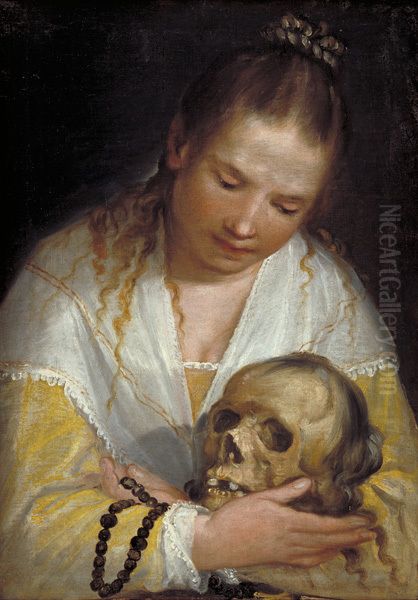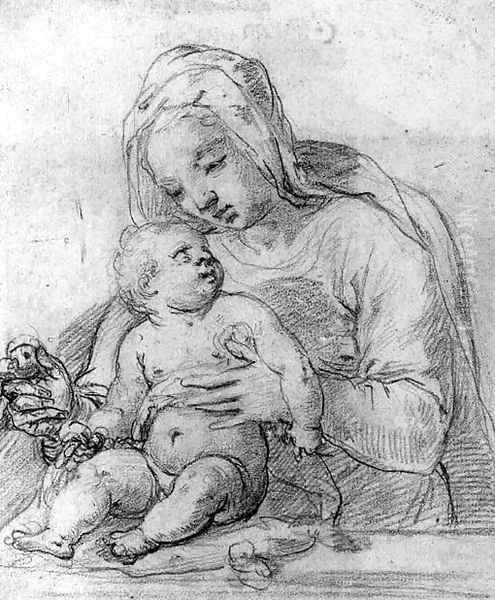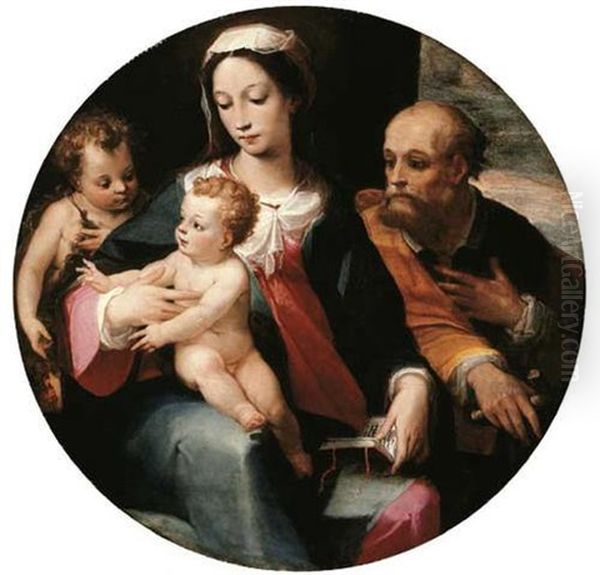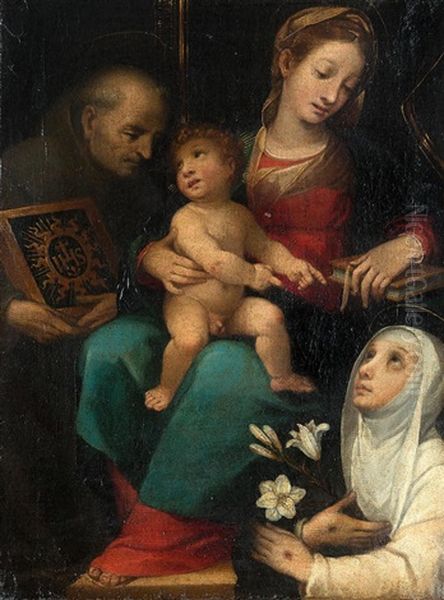Alessandro Casolani (1552/53 – 1607) stands as a significant, if sometimes overlooked, figure in the transition from the late Renaissance Mannerist style to the burgeoning Baroque in Italy. Born in Mensano, a castle near Casole d'Elsa, or possibly in Siena itself, he spent most of his prolific career in his native Siena, a city with a rich and distinct artistic heritage. His work, primarily focused on religious subjects, reflects both the enduring traditions of Sienese painting and the dynamic artistic currents emanating from Rome and Florence. Casolani's art is characterized by its graceful figures, fluid lines, and a subtle emotional depth, making him a key representative of Sienese painting in the late 16th and early 17th centuries.
Early Life and Sienese Artistic Heritage
Alessandro Casolani, also known as Alessandro della Torre, was born into an artistic family. His father may have been Lorenzo Rustici, a painter, and his brother, Ilario Casolani, also pursued a career as an artist. This familial environment likely provided his initial exposure to the craft. Siena, at the time of Casolani's youth, was a city still deeply proud of its artistic past, which included masters like Duccio di Buoninsegna, Simone Martini, and the Lorenzetti brothers (Pietro and Ambrogio), who had established a unique Sienese school known for its lyrical elegance and decorative beauty.
Later Sienese masters such as Domenico Beccafumi, the last great exponent of the Sienese Renaissance, left a profound mark on the city's artistic identity. Beccafumi's distinctive style, with its vibrant, almost iridescent colors, elongated figures, and intense emotionalism, was a potent local influence that Casolani would have absorbed. The artistic atmosphere of Siena, therefore, was one steeped in tradition yet open to the stylistic innovations that characterized Italian art in the 16th century.
Formative Influences and Training
Casolani's formal artistic training is primarily associated with two key figures: Arcangelo Salimbeni and Cristoforo Roncalli, known as Il Pomarancio. Arcangelo Salimbeni (c. 1536–1579) was a Sienese painter whose work exemplified the local Mannerist style, often infused with a gentle piety. Under Salimbeni, Casolani would have honed his skills in draughtsmanship and composition, absorbing the prevailing Sienese aesthetic.

His association with Cristoforo Roncalli (c. 1552–1626) was also crucial. Roncalli, a contemporary of Casolani, was a highly successful painter who worked extensively in Rome and was a significant figure in the late Mannerist and early Baroque periods. While some sources suggest Roncalli, out of courtesy, taught Casolani the fundamentals rather than taking him as a formal pupil, their interaction undoubtedly exposed Casolani to the more dynamic and monumental style developing in Rome. Roncalli himself was influenced by artists like Taddeo Zuccari and Federico Zuccari, and his work often displayed a robust energy and complex compositions.
Beyond his direct teachers, the influence of Federico Barocci (c. 1535–1612) from Urbino is evident in Casolani's art. Barocci's soft, sfumato-like modeling, tender religious sentiment, and vibrant, yet harmonious, color palette were widely admired and emulated. Casolani adopted some of Barocci's sweetness and grace, though often with a more simplified and linear approach. Indeed, his style has been described as retaining Barocci's simplification but with a greater emphasis on fluid lines, aligning with late 16th-century Florentine trends as seen in the works of artists like Santi di Tito or Jacopo da Empoli.
The Roman Sojourn and Artistic Development
Around 1578, Casolani traveled to Rome, a pivotal experience for any ambitious artist of the period. Rome was the epicenter of artistic innovation, where painters from all over Italy and Europe converged. During this time, he would have encountered the works of established masters and the emerging talents who were shaping the future of art. The influence of Roman Mannerism, with its sophisticated elegance and intellectual complexity, as practiced by artists like Cavalier d'Arpino (Giuseppe Cesari), would have been palpable.
In Rome, Casolani is documented as having worked on frescoes, including in the church of San Silvestro in Capite. This experience in large-scale mural decoration would have further developed his skills in narrative composition and perspective, a key element in his later works. His Roman period allowed him to assimilate broader Italian artistic trends, moving beyond purely Sienese conventions and developing a more cosmopolitan style, though always retaining a certain Sienese grace.
Artistic Style and Characteristics
Alessandro Casolani's artistic style is a nuanced blend of Sienese tradition, Mannerist elegance, and early Baroque sensibilities. His figures are typically slender and graceful, often imbued with a gentle melancholy or serene piety. He possessed a remarkable facility for drawing, evident in the fluid, calligraphic lines that define his forms. This emphasis on line connects him to the Florentine tradition of disegno.

His color palette is often soft and harmonious, with a preference for delicate flesh tones and subtly modulated draperies. While capable of more vibrant hues, he generally favored a restrained chromatic range that enhanced the lyrical quality of his work. Light and shadow are handled with sensitivity, creating a gentle chiaroscuro that models forms without harsh contrasts, distinguishing his work from the more dramatic tenebrism of Caravaggio, with whom his works were occasionally confused, likely due to a shared intensity in certain religious depictions rather than a direct stylistic similarity.
Compositionally, Casolani's works are well-ordered, often featuring a clear narrative structure. He adeptly managed multi-figure compositions, particularly in his frescoes and larger altarpieces, arranging figures in dynamic yet balanced groupings. His understanding of perspective, likely refined during his time in Rome, allowed him to create convincing spatial depth. The overall effect of his art is one of refined elegance, emotional sincerity, and technical proficiency. He navigated the transition from the artificiality of High Mannerism towards a greater naturalism and emotional directness characteristic of the early Baroque, without fully abandoning the grace of the former.
Major Works and Thematic Concerns
Casolani was a prolific artist, and his oeuvre consists mainly of religious paintings, including altarpieces, devotional images, and extensive fresco cycles for churches and confraternities in Siena and surrounding areas, as well as in Naples and Genoa.
One of his most celebrated works is The Martyrdom of St. Bartholomew, created for the church of San Niccolò del Carmine in Siena. This painting was highly praised by the Bolognese Baroque master Guido Reni, who reportedly considered it one of the finest paintings he had ever seen and a precursor to modern painting. Such acclaim from a leading artist like Reni underscores Casolani's contemporary reputation. The work likely displayed a powerful combination of dramatic intensity and compositional clarity, characteristic of the Counter-Reformation's call for art that was both moving and legible.
His depictions of the Madonna and Child are numerous and showcase his ability to convey tenderness and divine grace. Examples can be found in various collections, including one in the National Gallery of Australia. These works often feature the Virgin with soft, idealized features, cradling an infant Christ who engages the viewer or other sacred figures, such as the young St. John the Baptist.

Casolani was also a skilled fresco painter. He contributed to the decoration of the Oratory of the Santissima Trinità in Siena, a common project for many Sienese artists of the period, including Ventura Salimbeni and Francesco Vanni. He also executed frescoes in the Basilica di San Domenico in Siena, a major Dominican church. His Pala di San Alfonso (Altarpiece of St. Alphonsus receiving the habit), likely for a church in Naples or Siena, further demonstrates his capacity for large-scale narrative works.
A fascinating insight into his creative process is offered by studies for works like Woman Contemplating a Skull. Preparatory drawings reveal his method of refining compositions, adjusting figures, and exploring different emotional nuances before committing to the final version, highlighting his thoughtful approach to art-making.
The Casolani Workshop and Collaborations
Like many successful artists of his time, Alessandro Casolani likely ran an active workshop to assist with the numerous commissions he received. His brother, Ilario Casolani, and his son, Cristoforo Casolani (who later became a monk and was known as Fra Ilario), were also painters and may have collaborated with him or continued his style. Another family member, Vincenzo Rustici (possibly his half-brother or step-brother, if Lorenzo Rustici was Alessandro's father), was also a painter active in Siena, known for his depictions of public festivals.
The workshop system was essential for producing large altarpieces and extensive fresco cycles. Assistants would help with preparing surfaces, transferring cartoons, painting less critical areas, and producing copies or variations of successful compositions. This collaborative environment was standard practice and allowed artists like Casolani to undertake ambitious projects. His interactions with other leading Sienese artists, such as Francesco Vanni and Ventura Salimbeni (Arcangelo's son and thus a close associate, possibly even a step-brother to Casolani), were also significant. These artists often competed for commissions but also collaborated and influenced one another, creating a vibrant artistic scene in Siena.
Contemporaries and the Artistic Milieu
Alessandro Casolani operated within a dynamic artistic landscape. In Siena, he was a contemporary of Francesco Vanni (1563–1610) and Ventura Salimbeni (1568–1613), both of whom were highly successful and, like Casolani, were influenced by Barocci and Roman trends. These three artists formed the leading triumvirate of Sienese painting at the turn of the 17th century. Other Sienese painters of the period included Rutilio Manetti, who would later embrace a more Caravaggesque style.

Beyond Siena, Casolani's career coincided with major shifts in Italian art. In Rome, the late Mannerism of figures like Cavalier d'Arpino was being challenged by the revolutionary naturalism of Michelangelo Merisi da Caravaggio (1571–1610) and the classicizing reforms of the Carracci brothers – Annibale, Agostino, and Ludovico – who founded an influential academy in Bologna. While Casolani's style remained more aligned with the graceful Sienese tradition and the softer aspects of Barocci's art, he was undoubtedly aware of these powerful new currents. His occasional misattribution to Caravaggio or Barocci speaks to a certain shared intensity or tenderness, respectively, that resonated with contemporary viewers. Other notable painters active during parts of his career include Florentines like Passignano (Domenico Cresti) and Cigoli (Ludovico Cardi), who were also navigating the transition towards the Baroque.
Legacy and Reassessment
Alessandro Casolani died in Siena in 1607 (some sources state 1606). For a period, his work, like that of many artists active during transitional phases, was somewhat overshadowed by the more dramatic innovations of the High Baroque. However, art historical scholarship has increasingly recognized his importance as a key figure in Sienese painting and as an artist who skillfully blended diverse influences into a coherent and appealing personal style.
His works are preserved in numerous churches in Siena and Tuscany, as well as in major museum collections, including the Uffizi Gallery in Florence, the Pinacoteca Nazionale in Siena, and the Capitoline Museums in Rome. The fact that his paintings were sometimes mistaken for those of more famous masters like Barocci or even Caravaggio, while problematic for attribution, also suggests the high quality and expressive power of his art.
Modern appreciation for Casolani centers on his elegant draughtsmanship, his gentle and sincere portrayal of religious emotion, and his role in sustaining a vibrant artistic tradition in Siena while engaging with broader Italian developments. He represents a bridge between the refined aesthetic of late Mannerism and the more direct emotional appeal of the early Baroque, creating a body of work that is both historically significant and aesthetically pleasing.
Conclusion
Alessandro Casolani was a gifted and productive painter whose career spanned a crucial period of artistic transformation in Italy. Rooted in the rich artistic soil of Siena, he absorbed the lessons of local masters like Beccafumi and his teacher Arcangelo Salimbeni, while also embracing the sophisticated influences of Roman art through figures like Roncalli and the pervasive appeal of Barocci's tender style. His art, characterized by its fluid linearity, harmonious color, and sincere emotional expression, made a significant contribution to the religious art of his time. While perhaps not as revolutionary as some of his contemporaries, Casolani's consistent quality, his ability to synthesize diverse influences, and the sheer beauty of his paintings secure his place as an important master of the late Sienese school, an artist who gracefully navigated the currents between Mannerism and the emerging Baroque. His legacy endures in the numerous altarpieces and frescoes that still adorn churches and collections, testaments to a dedicated and skilled artistic career.